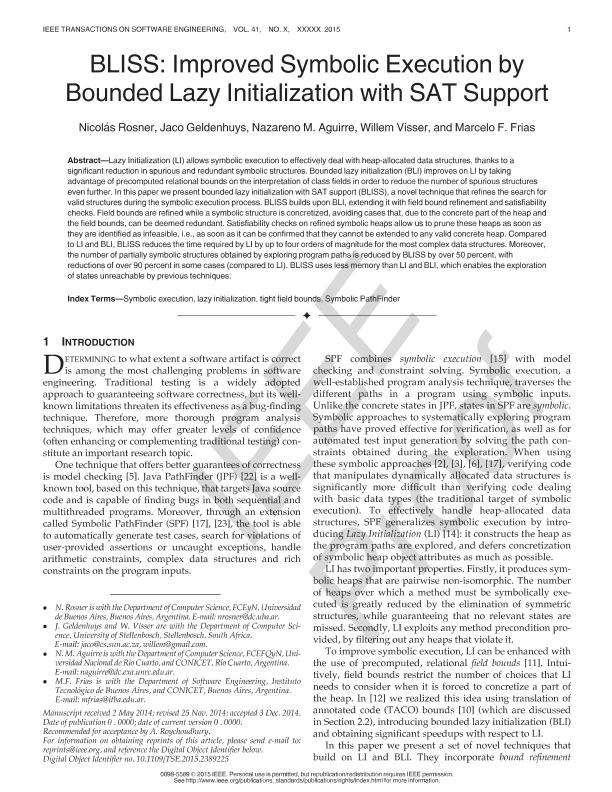Mostrar el registro sencillo del ítem
dc.contributor.author
Rosner, Nicolas Leandro

dc.contributor.author
Geldenhuys, Jaco
dc.contributor.author
Aguirre, Nazareno Matias

dc.contributor.author
Visser, Willem
dc.contributor.author
Frias, Marcelo Fabian

dc.date.available
2018-04-20T14:12:18Z
dc.date.issued
2015-07
dc.identifier.citation
Rosner, Nicolas Leandro; Geldenhuys, Jaco; Aguirre, Nazareno Matias; Visser, Willem; Frias, Marcelo Fabian; BLISS: Improved Symbolic Execution by Bounded Lazy Initialization with SAT Support; IEEE Computer Society; IEEE Transactions On Software Engineering; 41; 7; 7-2015; 639-660
dc.identifier.issn
0098-5589
dc.identifier.uri
http://hdl.handle.net/11336/42805
dc.description.abstract
Lazy Initialization (LI) allows symbolic execution to effectively deal with heap-allocated data structures, thanks to a significant reduction in spurious and redundant symbolic structures. Bounded lazy initialization (BLI) improves on LI by taking advantage of precomputed relational bounds on the interpretation of class fields in order to reduce the number of spurious structures even further. In this paper we present bounded lazy initialization with SAT support (BLISS), a novel technique that refines the search for valid structures during the symbolic execution process. BLISS builds upon BLI, extending it with field bound refinement and satisfiability checks. Field bounds are refined while a symbolic structure is concretized, avoiding cases that, due to the concrete part of the heap and the field bounds, can be deemed redundant. Satisfiability checks on refined symbolic heaps allow us to prune these heaps as soon as they are identified as infeasible, i.e., as soon as it can be confirmed that they cannot be extended to any valid concrete heap. Compared to LI and BLI, BLISS reduces the time required by LI by up to four orders of magnitude for the most complex data structures. Moreover, the number of partially symbolic structures obtained by exploring program paths is reduced by BLISS by over 50 percent, with reductions of over 90 percent in some cases (compared to LI). BLISS uses less memory than LI and BLI, which enables the exploration of states unreachable by previous techniques.
dc.format
application/pdf
dc.language.iso
eng
dc.publisher
IEEE Computer Society

dc.rights
info:eu-repo/semantics/openAccess
dc.rights.uri
https://creativecommons.org/licenses/by-nc-sa/2.5/ar/
dc.subject
Symbolic Execution
dc.subject
Lazy Initialization
dc.subject
Tight Field Bounds
dc.subject
Symbolic Pathfinder
dc.subject.classification
Ciencias de la Computación

dc.subject.classification
Ciencias de la Computación e Información

dc.subject.classification
CIENCIAS NATURALES Y EXACTAS

dc.title
BLISS: Improved Symbolic Execution by Bounded Lazy Initialization with SAT Support
dc.type
info:eu-repo/semantics/article
dc.type
info:ar-repo/semantics/artículo
dc.type
info:eu-repo/semantics/publishedVersion
dc.date.updated
2018-04-11T15:12:40Z
dc.journal.volume
41
dc.journal.number
7
dc.journal.pagination
639-660
dc.journal.pais
Estados Unidos

dc.journal.ciudad
Los Alamitos
dc.description.fil
Fil: Rosner, Nicolas Leandro. Universidad de Buenos Aires. Facultad de Ciencias Exactas y Naturales. Departamento de Computación; Argentina
dc.description.fil
Fil: Geldenhuys, Jaco. University of Stellenbosch; Sudáfrica
dc.description.fil
Fil: Aguirre, Nazareno Matias. Consejo Nacional de Investigaciones Científicas y Técnicas; Argentina. Universidad Nacional de Río Cuarto. Facultad de Ciencias Exactas Fisicoquímicas y Naturales. Departamento de Computación; Argentina
dc.description.fil
Fil: Visser, Willem. University of Stellenbosch; Sudáfrica
dc.description.fil
Fil: Frias, Marcelo Fabian. Instituto Tecnológico de Buenos Aires; Argentina. Consejo Nacional de Investigaciones Científicas y Técnicas; Argentina
dc.journal.title
IEEE Transactions On Software Engineering

dc.relation.alternativeid
info:eu-repo/semantics/altIdentifier/doi/http://dx.doi.org/10.1109/TSE.2015.2389225
dc.relation.alternativeid
info:eu-repo/semantics/altIdentifier/url/https://ieeexplore.ieee.org/document/7004061/
Archivos asociados
